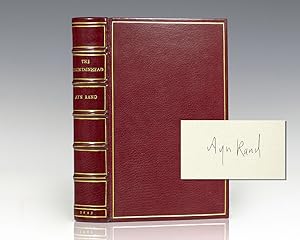The Fountainhead by Ayn Rand, First Edition, Signed (13 results)
FeedbackSearch filters
Product Type
- All Product Types
- Books (13)
- Magazines & Periodicals (No further results match this refinement)
- Comics (No further results match this refinement)
- Sheet Music (No further results match this refinement)
- Art, Prints & Posters (No further results match this refinement)
- Photographs (No further results match this refinement)
- Maps (No further results match this refinement)
- Manuscripts & Paper Collectibles (No further results match this refinement)
Condition Learn more
- New (No further results match this refinement)
- As New, Fine or Near Fine (4)
- Very Good or Good (3)
- Fair or Poor (No further results match this refinement)
- As Described (6)
Binding
Collectible Attributes
Language (2)
Price
- Any Price
- Under US$ 25 (No further results match this refinement)
- US$ 25 to US$ 50 (No further results match this refinement)
- Over US$ 50
Free Shipping
Seller Location
Seller Rating
-
The Fountainhead
Published by The Bobbs-Merrill Company, New York, 1943
Language: English
Seller: Magnum Opus Rare Books, Missoula, MT, U.S.A.
First Edition Signed
Hardcover. Condition: Fine. Dust Jacket Condition: Fine. 1st Edition. First Edition, early issue INSCRIBED and SIGNED by Ayn Rand on the front endpaper. This book is also SIGNED by Nathanial Braden and his wife Barbara Branden, who has dated the book two weeks after Rand's inscription. Two years earlier Nathaniel Braden and Barbara Branden had written the book "Who is Ayn Rand" This original dustjacket has NO chips or tears with some repair. The book is bound in the publisher's cloth and is in excellent condition. The binding is tight with NO cocking or leaning and the boards are crisp. The pages are clean with NO writing, marks or bookplates in the book. A beautiful copy SIGNED by the author. Signed by Author(s).
-
The Fountainhead.
Published by The Bobbs-Merrill Company, Indianapolis and New York, 1966
Seller: Raptis Rare Books, Palm Beach, FL, U.S.A.
First Edition Signed
Early printing of Randsās breakthrough work and her first major literary success. Octavo, original cloth. Presentation copy, warmly inscribed by the author on the front free endpaper, "To Patty Martin- Affectionately, Ayn Rand March 21, 1951." Near fine in a very good dust jacket. Although Rand was a previously published novelist and had a successful Broadway play, she faced difficulty in finding a publisher she thought right for The Fountainhead. She let Macmillian Publishing go when they rejected her demand for better publicity (Branden, 1986), and when her agent criticized the novel, she fired him and handled submissions herself (Burns, 2009). After sifting through eleven more publishers, Rand finally released The Fountainhead with Bobbs-Merrill Company in 1943. The reception was instant, and The Fountainhead became a bestseller in two years. The protagonist, Howard Roark, whose character was thought to be inspired by Frank Lloyd Wright, is a young architect fighting against convention. Cited by numerous architects as an inspiration, Ayn Rand said the theme of the book was "individualism versus collectivism, not within politics but within a man's soul." Rand chose architecture as the analogy of her heady themes because of the context of the ascent of modern architecture. It provided an appropriate mode to make relevant her beliefs that the individual is of supreme value, the "fountainhead" of creativity, and that selfishness, properly understood as ethical egoism, is a virtue. Some critics consider The Fountainhead to be Rand's best novel (Merill, 1991). Indeed, philosopher Mark Kingwell described it as "Rand's best work" (Kingwell, 2006). In 1949 it was adapted to film, produced by Henry Blanke, directed by King Vidor, starring Gary Cooper, Patricia Neal, Raymond Massey, Robert Douglas, and Kent Smith.
-
The Fountainhead
Published by Signet, 1952
Seller: PEN ULTIMATE RARE BOOKS, Pine Plains, NY, U.S.A.
First Edition Signed
Soft cover. Condition: Near Fine. 1st Edition. First printing paperback edition of The Fountainhead. Perinn A.3e. Inscribed by Ayn Rand to her Signet publisher: "To Kurt Enoch - wishing you a great success on your triple volumes, with pleasure at being the first of them - Cordially - Ayn Rand 5/6/1952." An historic inscription by Rand within a month of publication. Book Near Fine with only slight wear at the spine. "I know the nature of this novel. I do not care to become famous for any other" (Ayn Rand, speaking of The Fountainhead shortly after publication with New York Herald Tribune columnist Isabel Paterson, 1943). The Fountainhead, her third novel, became Rand's breakthrough novel and first bestseller, the novel that would indeed make her famous. The Fountainhead chronicles the life of an independent architect of genius, struggling to make a career against a society committed to tradition and mediocrity. It celebrates the glory of personal integrity and defines a new morality of individualism. What she became famous for was Ayn Rand - the Individualist -- Ayn Rand - Liberator of the inviolate, creative, reasoning mind -- Ayn Rand - Champion of stainless personal integrity -- Ayn Rand - Creator of the first unbowed man of unborrowed vision. Originally published in 1943 by Bobbs Merrill, The Fountainhead first became a bestseller in 1945, and it reappeared as a bestseller in 1949, when Warner Bros. released its motion picture The Fountainhead. By 1952, when this Signet Triple Volume paperback edition appeared, The Fountainhead had sold more than half a million copies. (Branden, 1962). While Signet's Triple Volume format would typically include three works by a single author or three related themes, The Fountainhead by Ayn Rand was, as Rand s inscription makes clear, the first Signet Triple Volume book published and the first paperback edition of Rand's hardcover bestseller. From the library of Kurt Enoch, (1896-1982), the "Paperback Pioneer," a paperback innovator in his native Germany before fleeing Hitler in 1936. He helped Ian Ballantine initiate Penguin in the US, became its president, and then, with Victor Weybright, launched New American Library of World Literature in 1947, publishing a wide range of contemporary and classic titles under its NAL, Signet, and Mentor imprints. In effect Enoch created the mass market paperback, offering works of many great authors to a younger generation as well as to underrepresented reading demographics From the outset, Enoch asked his authors to inscribe their paperback editions to him. Over the next two decades, he amassed a unique collection, which grew to more than a thousand volumes. Other signatories include William Faulkner, Vladimir Nabokov, James Baldwin, Ian Fleming, Graham Greene, Saul Bellow, Norman Mailer, Flannery O'Connor, C.G. Jung, John Steinbeck, James M. Cain, John Le Carre, Mickey Spillane, John Howard Griffin, Richard Wright, and Martin Luther King. Paperbacks with such historic association are rarely found signed by their authors. For these reasons, Enoch's collection is both exceptional and historic. As the first book offered to the public under Enoch's seminal imprint, this first edition paperback copy of The Fountainhead, inscribed to its publisher, underscores its unique, groundbreaking position. Book #Bv1323. $7000. We specialize in rare Ayn Rand, and other legends and landmarks. Signed by Author(s).
-
The Fountainhead
Published by Bobbs Merrill, 1968
Seller: PEN ULTIMATE RARE BOOKS, Pine Plains, NY, U.S.A.
First Edition Signed
Hardcover. Condition: Fine. Dust Jacket Condition: Fine. 1st Edition. "I know the nature of this novel," announced an unknown Ayn Rand to Isabel Paterson upon the original publication of The Fountainhead, 1943. "I do not care to become famous for any other" (Branden, 177). Rand got what she cared for! SIGNED/Inscribed 25 Anniversary Edition, 1968, First Printing, of Rand's enduring celebration of the individual spirit -- its timeless theme, "individualism vs. collectivism, not in politics but in man's soul" -- in its dust jacket featuring a reproduction of a painting by Rand's artist-husband, Frank O'Connor. Perinn A3g. This edition includes the special Introduction Rand wrote for the Anniversary. If you first read The Fountainhead between 1968 and 1993 as I did, this is very likely the first appearance of the edition you read. Originally rejected by twelve publishers, "some of whom declared it was 'too intellectual," 'too controversial,' and would not sell because no audience existed for it" (Rand, Introduction to The Fountainhead, 1968), The Fountainhead is now considered a modern classic, STILL in print in hardcover more than 80 years after its original publication. "This is one of the cardinal reasons behind The Fountainhead's lasting appeal: it is a confirmation of the spirit of youth, proclaiming man's glory, showing how much is possible" (Introduction). A fine copy in a fine jacket with only minor edgewear; no writings or marks of any kind save for Rand's inscription on the half-title Outstanding provenance: this copy inscribed to one of Rand's employees in the year of publication. An extraordinarily rare Rand acquisition in highly prized condition. Book #Bv2427. $15,000. We specialize in rare Ayn Rand, and other legends and landmarks. Signed by Author(s).
-
The Fountainhead (Signed Early Printing)
Published by The Blakiston Company, Philadelphia, Pennsylvania, 1943
Seller: The BiblioFile, Rapid River, MI, U.S.A.
First Edition Signed
Hardcover. Condition: Very Good. Dust Jacket Condition: Very Good. First Edition Thus. Beautifully signed by Ayn Rand at front endpaper: "Ayn Rand". Rare contemporaneous signature with mid 1940s release of "The Fountainhead" featuring the distinct looped "y" in Ayn's earlier signatures. Very attractive. Rare flat signed example; without inscription or other marks. Copyright, 1943, The Bobbs-Merrill Company. First edition, early issue with printing errors sublicensed by original publisher Bobbs-Merrill due to wartime paper shortages. Publishers were given quotas and Blakiston had paper to spare. Original Bobbs-Merrill design with stylized gilt impresssed cover titles, green full cloth boards and matching printing plates, text design. Dark green full cloth boards, gilt cover and spine titles, light shelf, corner wear, rub. Pages near fine, clean; no writing. Exterior block remains bright and clean. Bind fine, square; hinges intact. Slight hinge gap at front; firm and solid. Contains first edition points: page number 9 appears as o; referred mispelled refrred at 5th line of page 321; G. W. at page 381; Dominique mispelled Domininque at page 480. Preserved in early issue original wrapper, moderate edge wear, rub, crease; with unclipped 3.00, protected in new clear sleeve. Original art deco first edition design in orange and brown with white three dimensional bold block titles. Ayn Rand sepia portrait and reviews for this title at back panel. Very attractive. Rare sharp signed early printing in near very good wrapper. The Fountainhead is "rational self-interest," a view that people are more useful when improving themselves to offer most benefit to the world. It demonstrates individual achievement and productiveness over group collectivism. Roark is the embodiment of rational self-interest, as well as the Rand virtues of diligence, determination, originality and artistic excellence. The Fountainhead is a great and challenging novel based on a supreme belief in the rights of the individual. An unprecedented phenomenon in modern literature. Arguably the century's most challenging novel of ideas; when first published it created a public furor and worldwide interest in Ayn Rand. On the surface, it is the story of a gifted young architect, his violent battle with conventional standards, and his explosive love affair with the beautiful woman who struggles to defeat him. In his fight for success, he first discovers and then rejects the seductive power of fame and money, finding that individual integrity must ultimately triumph. The story addresses a number of universal themes: the strength of the creative soul, the tug between good and evil, and the threat of fascism, whether overt or hidden. The confrontation of these themes, along with the amazing stroke of Rand's writing, combine to give this creative classic its enduring influence. More relevant today than when written. Manufactured in the United States. Size: 12mo - over 6¾" - 7¾" tall. Signed by Author. Book.
-
The Fountainhead
Published by Bobbs Merrill, 1943
Seller: PEN ULTIMATE RARE BOOKS, Pine Plains, NY, U.S.A.
First Edition Signed
Hardcover. Condition: Near Fine. Dust Jacket Condition: Very Good. 1st Edition. SIGNED First Edition. Bobbs-Merrill (1943). Octavo, original maroon cloth, original dust jacket. Housed in a custom clamshell box. "I know the nature of this novel," announced Ayn Rand to Isabel Paterson upon publication of The Fountainhead. "I do not care to become famous for any other" (Branden, 177). SIGNED First Edition, First Printing of Rand's breakthrough bestseller, her enduring celebration of the individual spirit -- its timeless theme, "individualism vs. collectivism, not in politics but in man's soul" -- in its extraordinarily rare first-state dust jacket with back panel listing of 16 Bobbs-Merrill books. Perinn A3a. In The Fountainhead, "Rand has taken her stand against collectivism, 'the rule of the second-hander, the ancient monster' which has brought men 'to a level of indecency never equaled on earth'. She has written a hymn in praise of the individual" (Pruette, 1943). When Rand began writing her first notes for The Fountainhead in 1935, before her first novel, We the Living, was published, she knew she had set for herself a unique, unprecedented literary and philosophical goal: the projection of her ideal man, the creative, unsubmissive man of unborrowed vision, of self-sufficient ego -- and "a defense of egoism in its real meaning" (Notes, 1935). By 1937, as she began writing the novel, her royalties from We the Living had dried up; Macmillan destroyed the type after selling all 3000 copies of its first printing. After completing one-third of her new novel, Rand hoped to procure a $1200 advance from a publisher, allowing her to work full-time on "Second Hand Lives," her original title for the novel. Instead, the novel was rejected by twelve publishers, "some of whom declared it was 'too intellectual," 'too controversial,' and would not sell because no audience existed for it" (Rand, Introduction to The Fountainhead, 1968). Rand, armed with the iron determination of her hero Roark, represented the novel herself after firing her literary agent. In 1941, she secured a $1000 advance from Indianapolis-based Bobbs-Merrill. Rand devoted herself throughout 1942 to completing the manuscript. The Fountainhead was published on May 7, 1943. (Lisi: "The Fountainhead's Long Road to Publication", 2024) Because of the imminent paper shortage during the war, Bobbs-Merrill issued a series of small early printings until 1945 when the novel became a soaring bestseller. In first Edition, First Printing, First State, it remains one of Rand's most difficult and rarest acquisitions. This Signed Stated "First Edition" copy -- a first, First, FIRST! -- near-fine with no writings or markings of any kind save for Rand's inscription on the title page. Housed in a sturdy custom clamshell box. From one of the world's finest essential Ayn Rand and other landmark books collections. Book #vBP1404. $95,000. We specialize in Rare Ayn Rand, and other legends and landmarks. Signed by Author(s).
-
The Fountainhead [First Printing]
Published by The Bobbs-Merrill Company, Indianapolis - New York, 1943
Seller: The BiblioFile, Rapid River, MI, U.S.A.
First Edition Signed
Hardcover. Condition: Very Good. Dust Jacket Condition: Very Good. First Edition. First edition stated. Rare sharp first printing. Beautifully signed by Ayn Rand on signature cut lightly adhered at title page: "Ayn Rand". Very attractive. Stated at copyright page: "Copyright, 1943, The Bobbs-Merrill Company. Manufactured in the United States. First Edition." First state red cloth cover; 6" x 8 3/4" design, larger than later printings. Dark red full-cloth boards, gilt cover and spine titles, moderate shelf wear, toning. Light red tint to exterior top-stain. Slightly deckled pages, very good; clean with attractive toning. Antiquarian owner's stamp behind front flap: "Joseph H. Cohen, 178 Dudley St., Brookline - Mass." Bind fine, square; hinges intact. Presented and preserved in facsimile of original first issue wrapper; protected in new clear sleeve. Rare very good first printing in fine facsimile wrapper. Additionally, set into volume, as page marker or novel reference, is a First Day of Issue commemorative envelope for the release of the classic 33 cent stamp honoring Ayn Rand's vision. This collectible features a 22k gold plated replica of the Rand stamp on maroon velvet background. An unprecedented phenomenon in modern literature. Arguably the century's most challenging novel of ideas; when first published it created a public furor and worldwide interest in Ayn Rand. On the surface, it is the story of a gifted young architect, his violent battle with conventional standards, and his explosive love affair with the beautiful woman who struggles to defeat him. In his fight for success, he first discovers and then rejects the seductive power of fame and money, finding that individual integrity must ultimately triumph. The story addresses a number of universal themes: the strength of the creative soul, the tug between good and evil, and the threat of fascism, whether overt or hidden. The confrontation of these themes, along with the amazing stroke of Rand's writing, combine to give this creative classic its enduring influence. More relevant today than when written. Printed at The Cornwall Press, Inc. Cornwall, N. Y. 754 pages. Insured post. Size: 8vo - over 7¾" - 9¾" tall. Signed by Author. Book.
-
THE FOUNTAINHEAD Signed
Published by Bobbs-Merrill, Indianapolis, IN, 1943
Seller: Rare Book Cellar, Pomona, NY, U.S.A.
First Edition Signed
Hardcover. First Edition; Early Printing. Very Good in a Very Good dust jacket. Some staining spots to edge pages Early issue. ; Signed by Ayn Rand on the title page. ; 8vo - over 7¾" - 9¾" tall; Original unclipped dust jacket protected by archival Brodart cover. All domestic orders shipped protected in a Box.; Signed by Author.
-
The Fountainhead.
Published by Bobbs-Merrill Company, Indianapolis, 1943
Seller: Raptis Rare Books, Palm Beach, FL, U.S.A.
First Edition Signed
First edition, first issue with first edition stated on the copyright page of the author's first major novel, as well as her first best-seller. Octavo, original red cloth. Association copy, inscribed by the author on the front free endpaper, "To Jack L. Warner - Thank you for your courage and for a magnificent picture - with my profound gratitude - Ayn Rand. January 7, 1949." The recipient, Jack Warner, was the co-founder, president, and driving force behind the Warner Bros. Studios. His career spanned some 45 years, its duration surpassing that of any other of the seminal Hollywood studio moguls. Rand sold the film rights to Warner several years earlier with the contractual proviso that she would provide the screenplay, which would be unalterable. In fact, the director wanted changes, but Warner supported the author and honored the contract. This book's inscription, clearly referring to this, was presented about a half year prior to the film's release. Of Rand's fiction, The Fountainhead is generally conceded to be her most important and enduring work, a passionate portrait of uncompromising individualism. In the decades since its debut, the film has gained the critical acceptance, even the acclaim, that initially evaded it. Near fine in a near fine first-issue dust jacket with a touch of rubbing and no fading to the spine, which is endemic to this title. Housed in a custom full morocco clamshell box by The Harcourt Bindery. One of the finest association copies possible, linking the famed author with the legendary founder of Warner Brothers and producer of the iconic film. Although Rand was a previously published novelist and had a successful Broadway play, she faced difficulty in finding a publisher she thought right for The Fountainhead. She let Macmillian Publishing go when they rejected her demand for better publicity (Branden, 1986), and when her agent criticized the novel, she fired him and handled submissions herself (Burns, 2009). After sifting through eleven more publishers, Rand finally released The Fountainhead with Bobbs-Merrill Company in 1943. The reception was instant, and The Fountainhead became a bestseller in two years. The protagonist, Howard Roark, whose character was thought to be inspired by Frank Lloyd Wright, is a young architect fighting against convention. Cited by numerous architects as an inspiration, Ayn Rand said the theme of the book was "individualism versus collectivism, not within politics but within a man's soul." Rand chose architecture as the analogy of her heady themes because of the context of the ascent of modern architecture. It provided an appropriate mode to make relevant her beliefs that the individual is of supreme value, the "fountainhead" of creativity, and that selfishness, properly understood as ethical egoism, is a virtue. Some critics consider The Fountainhead to be Rand's best novel (Merill, 1991). Indeed, philosopher Mark Kingwell described it as "Rand's best work" (Kingwell, 2006). In 1949 it was adapted to film, produced by Henry Blanke, directed by King Vidor, starring Gary Cooper, Patricia Neal, Raymond Massey, Robert Douglas, and Kent Smith.
-
The Fountainhead.
Published by The Bobbs-Merrill Company, Indianapolis and New York, 1962
Seller: Raptis Rare Books, Palm Beach, FL, U.S.A.
First Edition Signed
Later printing of Randsās breakthrough work and her first major literary success. Octavo, original cloth. Presentation copy, inscribed by the author on the front free endpaper, "To Maurice Sabbah- With my best wishes Ayn Rand 3/5/63." Near fine in a near fine dust jacket without the usual fading to the spine. An exceptional example. Although Rand was a previously published novelist and had a successful Broadway play, she faced difficulty in finding a publisher she thought right for The Fountainhead. She let Macmillian Publishing go when they rejected her demand for better publicity (Branden, 1986), and when her agent criticized the novel, she fired him and handled submissions herself (Burns, 2009). After sifting through eleven more publishers, Rand finally released The Fountainhead with Bobbs-Merrill Company in 1943. The reception was instant, and The Fountainhead became a bestseller in two years. The protagonist, Howard Roark, whose character was thought to be inspired by Frank Lloyd Wright, is a young architect fighting against convention. Cited by numerous architects as an inspiration, Ayn Rand said the theme of the book was "individualism versus collectivism, not within politics but within a man's soul." Rand chose architecture as the analogy of her heady themes because of the context of the ascent of modern architecture. It provided an appropriate mode to make relevant her beliefs that the individual is of supreme value, the "fountainhead" of creativity, and that selfishness, properly understood as ethical egoism, is a virtue. Some critics consider The Fountainhead to be Rand's best novel (Merill, 1991). Indeed, philosopher Mark Kingwell described it as "Rand's best work" (Kingwell, 2006). In 1949 it was adapted to film, produced by Henry Blanke, directed by King Vidor, starring Gary Cooper, Patricia Neal, Raymond Massey, Robert Douglas, and Kent Smith.
-
The Fountainhead.
Published by Bobbs-Merrill Company, Indianapolis, 1943
Seller: Raptis Rare Books, Palm Beach, FL, U.S.A.
First Edition Signed
First edition, first issue with first edition stated on the copyright page of the author's first major novel, as well as her first best-seller. Octavo, original red cloth. Association copy, inscribed by the author in the year of publication on the front free endpaper, "To Gertrude Lynneberg- - with my best wishes for long years of happiness- Ayn Rand November 16, 1943." The recipient, Gertrude Lynneberg was the sister-in- law to Linda Lynneberg, also known as Aslaug Lynneberg, a lifelong friend of Rand. Near fine in a very good first issue dust jacket with some chips and wear. Housed in a custom half morocco clamshell box made by the Harcourt Bindery. First editions in the original dust jacket are uncommon, association copies rare. Although Rand was a previously published novelist and had a successful Broadway play, she faced difficulty in finding a publisher she thought right for The Fountainhead. She let Macmillian Publishing go when they rejected her demand for better publicity (Branden, 1986), and when her agent criticized the novel, she fired him and handled submissions herself (Burns, 2009). After sifting through eleven more publishers, Rand finally released The Fountainhead with Bobbs-Merrill Company in 1943. The reception was instant, and The Fountainhead became a bestseller in two years. The protagonist, Howard Roark, whose character was thought to be inspired by Frank Lloyd Wright, is a young architect fighting against convention. Cited by numerous architects as an inspiration, Ayn Rand said the theme of the book was "individualism versus collectivism, not within politics but within a man's soul." Rand chose architecture as the analogy of her heady themes because of the context of the ascent of modern architecture. It provided an appropriate mode to make relevant her beliefs that the individual is of supreme value, the "fountainhead" of creativity, and that selfishness, properly understood as ethical egoism, is a virtue. Some critics consider The Fountainhead to be Rand's best novel (Merill, 1991). Indeed, philosopher Mark Kingwell described it as "Rand's best work" (Kingwell, 2006). In 1949 it was adapted to film, produced by Henry Blanke, directed by King Vidor, starring Gary Cooper, Patricia Neal, Raymond Massey, Robert Douglas, and Kent Smith.
-
The Fountainhead [First Edition with Signed Correspondence]
Published by The Bobbs-Merrill Company, Indianapolis - New York, 1943
Seller: The BiblioFile, Rapid River, MI, U.S.A.
First Edition Signed
Hardcover. Condition: Good. Dust Jacket Condition: Good. First Edition. Stated at copyright: First Edition. Maroon (dark red) full-cloth boards, gilt cover and spine titles, varying spine wear, crease, rub, bump. Pages very good; no writing. Bind good, moderate offset; hinges intact. Presented and preserved in an original second state wrapper of the first edition. Dust wrapper w/moderate shelf wear, rub; unclipped 3.00, protected in fine clear sleeve. Larger 6" x 8 3/4" design. Rare near very good first printing in same wrapper. Accompanying this first edition is a signed Ayn Rand letter dated June 5, 1946 in reference to the The Fountainhead motion picture in pre-production, written and hand signed: "Ayn Rand". Typed on original stationery with Hal Wallis Productions at Paramount Studios letterhead, the message conveys to Miss Nickie Tipps, apparently an producer's assistant, that Rand is happy that both the novel and the screenplay also composed by Rand, are both well liked. Letter has been folded in three. Included in this collection is the rare booklet referred to in signed letter entitled: "A Letter from Ayn Rand, Author of The Fountainhead". Moderate shelf wear, upper edge discoloration; saddle-stitch bind, fine. Issued by Bobbs-Merrill in response to the deluge of requests for details about the novel and its author. Rand addresses readers and interested parties on her motivation and intent in writing this intriguing novel of philosophical fiction. Finally, set into volume, as page marker or novel reference, are two First Day of Issue commemorative envelopes for the issuance of the classic 33 cent stamp honoring Ayn Rand's vision. The first features 22k gold plated replica of the Rand stamp on maroon velvet b.g.; and the second with a stylish period painting for The Fountainhead. Concise informative biography of her life and achievement on another matching card. The Fountainhead is an unprecedented phenomenon in modern literature. Arguably the century's most challenging novel of ideas; when first published it created a public furor and worldwide interest in Ayn Rand. On the surface, it is the story of a gifted young architect, his violent battle with conventional standards, and his explosive love affair with the beautiful woman who struggles to defeat him. In his fight for success, he first discovers and then rejects the seductive power of fame and money, finding that individual integrity must ultimately triumph. The story addresses a number of universal themes: the strength of the creative soul, the tug between good and evil, the threat of fascism, whether overt or hidden. The confrontation of these themes, along with the amazing stroke of Rand's writing, combine to give this creative classic its enduring influence. More relevant today than when written. 754 pages. Insured post. Size: 8vo - over 7¾" - 9¾" tall. Signed by Author. Book.
-
The Fountainhead.
Published by Bobbs-Merrill Company, Indianapolis, 1943
Seller: Raptis Rare Books, Palm Beach, FL, U.S.A.
First Edition Signed
First edition, first issue with first edition stated on the copyright page of the author's first major novel, as well as her first best-seller. Octavo, bound in full morocco, gilt titles to the spine, raised bands, gilt ruled to the front and rear panel, marbled endpapers, original red cloth bound in at rear. Boldly signed by Ayn Rand on the title page. In fine condition. Although Rand was a previously published novelist and had a successful Broadway play, she faced difficulty in finding a publisher she thought right for The Fountainhead. She let Macmillian Publishing go when they rejected her demand for better publicity (Branden, 1986), and when her agent criticized the novel, she fired him and handled submissions herself (Burns, 2009). After sifting through eleven more publishers, Rand finally released The Fountainhead with Bobbs-Merrill Company in 1943. The reception was instant, and The Fountainhead became a bestseller in two years. The protagonist, Howard Roark, whose character was thought to be inspired by Frank Lloyd Wright, is a young architect fighting against convention. Cited by numerous architects as an inspiration, Ayn Rand said the theme of the book was "individualism versus collectivism, not within politics but within a man's soul." Rand chose architecture as the analogy of her heady themes because of the context of the ascent of modern architecture. It provided an appropriate mode to make relevant her beliefs that the individual is of supreme value, the "fountainhead" of creativity, and that selfishness, properly understood as ethical egoism, is a virtue. Some critics consider The Fountainhead to be Rand's best novel (Merill, 1991). Indeed, philosopher Mark Kingwell described it as "Rand's best work" (Kingwell, 2006). In 1949 it was adapted to film, produced by Henry Blanke, directed by King Vidor, starring Gary Cooper, Patricia Neal, Raymond Massey, Robert Douglas, and Kent Smith.


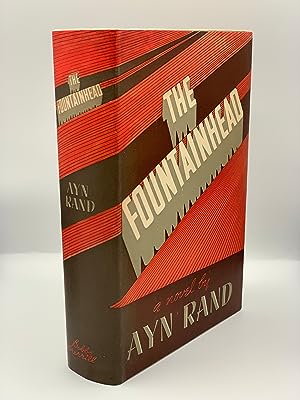





![Seller image for The Fountainhead [First Printing] for sale by The BiblioFile](https://pictures.abebooks.com/inventory/md/md31832383916.jpg)
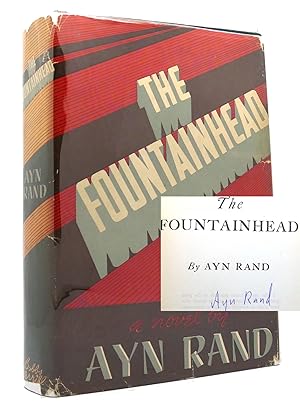
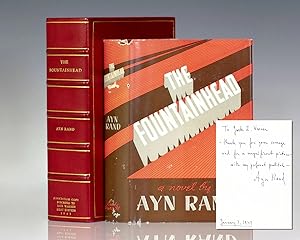
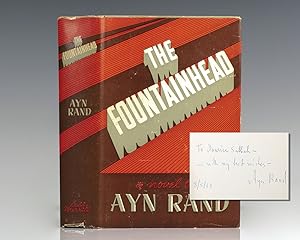

![Seller image for The Fountainhead [First Edition with Signed Correspondence] for sale by The BiblioFile](https://pictures.abebooks.com/inventory/md/md30751528679.jpg)
